Leading Project Team Development
|
| < Day Day Up > |
|
Due to the temporary and short-term nature of projects it can be tough for a group of strangers to come together, form relationships, and immediately create a successful project. Team development is the guidance, direction, and leadership the project manager offers to influence a project team.
The project managers are the power on the project team. While there may be some resistance of the project team to cooperate with the project manager, complete assigned duties, or participate as requested, the project team should realize the project manager is the project authority. There are five types of powers the project manager yields:
-
Expert The authority of the project manager comes from experience with the technology the project focuses on.
-
Reward The project manager has the authority to reward the project team.
-
Formal The project manager has been assigned by senior management and is in charge of the project. Also known as positional power.
-
Coercive The project manager has the authority to discipline the project team members. This is also known as “penalty power.” When the team is afraid of the project manager, it’s coercive.
-
Referent The project team personally knows the project manager. Referent can also mean the project manager refers to the person who assigned him the position—for example, “The CEO assigned me to this position so we’ll do it this way.” This power can also mean the project team wants to work on the project or with the project manager due to the high priority and impact of the project.
Creating Team-Building Activities
Team-building activities are approaches to develop the team through facilitated events. Events can include:
-
Team involvement during planning processes
-
Defining rules for handling team disagreements
-
Off-site activities
-
Quick team-involvement activities
-
Activities to improve interpersonal skills and form relationships
Dealing with Team Disagreements
In most projects, there will be instances when the project team, management, and other stakeholders disagree on the progress, decisions, and proposed solutions within the project. It’s essential for the project manager to keep calm, lead, and direct the parties to a sensible solution that’s best for the project. Here are seven reasons for conflict, in order of most common to least common:
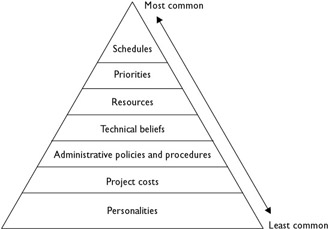
-
Schedules
-
Priorities
-
Resources
-
Technical beliefs
-
Administrative policies and procedures
-
Project costs
-
Personalities
Exam Watch
You can expect questions on these areas of conflict on the exam. Don’t be duped into thinking personality conflicts are the biggest problem with conflict resolution; they are the least important.
So what’s a project manager to do with all the potential for strife in a project? There are five different approaches to conflict resolution:
-
Problem solving This approach confronts the problem head-on and is the preferred method of conflict resolution. You may see this approach as “confronting” rather than problem solving. Problem solving calls for additional research to find the best solution for the problem, and should be a win-win solution. It should be used if there is time to work through and resolve the issue. It also serves to build relationships and trust.
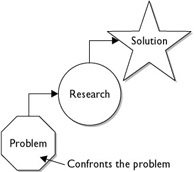
-
Forcing The person with the power makes the decision. The decision made may not be the best decision for the project, but it’s fast. As expected, this autocratic approach does little for team development and is a win-lose solution. Used when the stakes are high and time is of the essence, or if relationships are not important.
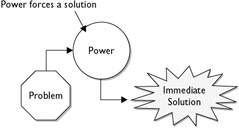
-
Compromising This approach requires that both parties give up something. The decision made is a blend of both sides of the argument. Because neither party really wins, it is considered a lose-lose solution. The project manager can use this approach when the relationships are equal and no one can truly “win.” This approach can also be used to avoid a fight.

-
Smoothing Smoothing “smoothes” out the conflict by minimizing the perceived size of the problem. It is a temporary solution but can calm team relations and boisterous discussions. Smoothing may be acceptable when time is of the essence or any of the proposed solutions will not currently settle the problem. This can be considered a lose-lose situation since no one really wins in the long-term. The project manager can use smoothing to emphasize areas of agreement between disagreeing stakeholders and thus minimize areas of conflict. It’s used to maintain relationships, and when the issue is not critical.

-
Withdrawal This is the worst conflict resolution approach since one side of the argument walks away from the problem, usually in disgust. The conflict is not resolved and it is considered a yield-lose solution. The approach can be used, however, as a cooling off period, or when the issue is not critical.
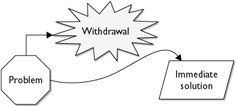
Relying on General Management Skills
A chunk of project management relies on general management skills. Specifically, the project manager relies on:
-
Leading Leading is the art of establishing direction, aligning people, and motivating the project team to complete the project work.
-
Communicating Good project managers are good communicators. Remember, half of communicating is listening.
-
Negotiating Project managers will likely negotiate for scope, cost, terms, assignment, and resources.
-
Problem solving Project managers must have the ability to confront and solve problems.
-
Influence Project managers use their influence to get things done.
Rewarding the Project Team
A reward and recognition system encourages, emphasizes, and promotes good performance and behavior by the project team. The reward and recognition system should be a formal, achievable approach for the project team to perform and be rewarded for their outstanding performance.
The relationship between the requirements for the reward and the power to achieve should not be limited. In other words, if the project manager is rewarded for completing a project by a given date, she needs the autonomy to schedule resources and make decisions so the goal is achievable.
The project team should be rewarded for good work and not for bad. For example, a project team should not be rewarded for completing a crucial assignment on schedule if the work is unacceptable because of quality issues.
Finally, the culture where the project is taking place should also be considered. It may be inappropriate to reward individual team members over an entire group, or vice versa. The project manager should be aware of the cultural differences and operate within the customs and practices of the environment to reward the project team without causing offense.
Dealing with Team Locales
Collocated teams are teams that work geographically close together to improve team dynamics and team relations. On large projects, it may be particularly valuable to bring all of the project team members together to a central location to work collectively on the project. A project headquarters or war room may be ideal.
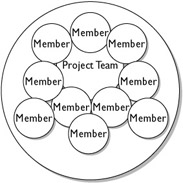
When collocation is not feasible, the project manager must make attempts to bring the project team together for team interaction, face-to-face meetings, and other avenues of communication to bolster relations.
Training the Project Team
The project team may require training to complete the project work, function as a project team, or participate in management skills such as finance or formal communications. Training can include:
-
Formal education
-
Classroom training
-
On-the-job training
-
Cross training (shadowing)
|
| < Day Day Up > |
|
EAN: 2147483647
Pages: 209